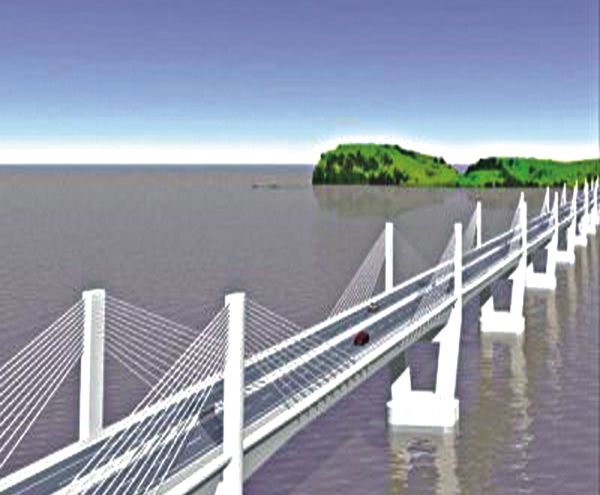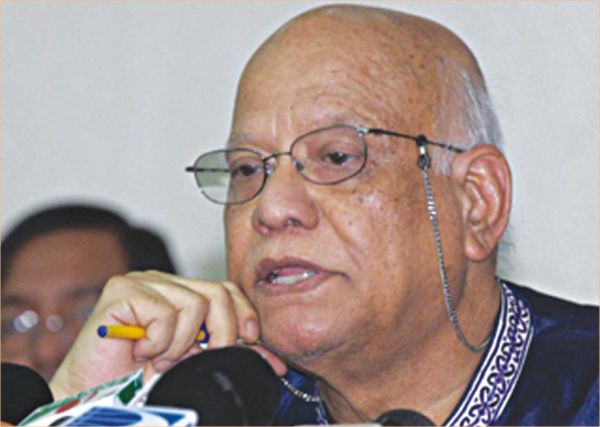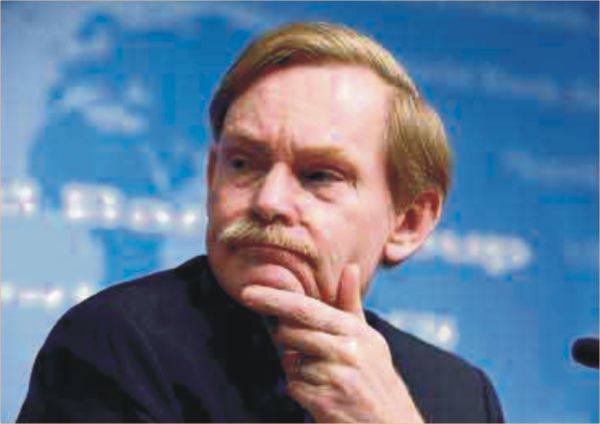
Inside
Original Forum |
| Causes of RMG unrest -- Refayet Ullah Mirdha |
| Who Pushes the Price up? -- Asjadul Kibria |
| Padma Bridge: Dream vs reality -- Mohammad Abdul Mazid |
Self-financing Padma Bridge -- Nofel Wahid |
| Unaccountability in Private Medical Services -- Mahbuba Zannat |
Medical Waste --- Mushfique Wadud |
Abysmal state of Emergency Medical Services |
On Clinical Negligence -- Eshita Tasmin |
The Population Growth Conundrum -- Ziauddin Chowdhury |
| Rohingyas and the 'Right to Have Rights' -- Bina D' Costa |
| Two-State Solution: Israeli-Palestinian Peace -- Dr Kamal Hossain |
| Forms of Government -- Megasthenes |
A Letter from Alghamdy and War Crimes Trial |
Padma Bridge:
Dream Vs Reality
Self-financing the Padma bridge sounds more like a chimera than a realistic plan, opines MUHAMMAD ABDUL MAZID.
 Star Archive
Star Archive
The construction of bridges in Bangladesh has never been an easy affair nor has it been without controversies. Funding has always been a central problem along with inordinate delay and corruption. Heavy dependency on foreign funds compounded with crude conditionalities remains the prime reason behind all these delays and controversies as well as corruptions. Of late, funding the Padma bridge has given rise to such a controversy. A debate on self-financing the bridge has also followed. Having looked into the pros and cons of self-financing, I will try to show that self-financing the biggest bridge of the country does not sound realistic at all.
Before delving into the debate, I'll shortly provide a little history of how construction of the bridge was conceived.
The first pre-feasibility study for the Padma Bridge project was conducted in May-October 1999. Detailed studies were conducted from May 2003 to May 2005 and a PCP was placed at the ECNEC in June 2005. Further studies were done and financing options were explored until the ECNEC approved the Padma Multipurpose Bridge Project worth Tk. 10,166 crore (Donor- GoB ratio 68:32) on August 20, 2007. The past caretaker government initiated the design work of the project with the financial assistance of the Asian Development Bank. In January 2009, the government decided to appoint a consulting firm for the design work. The Bangladesh Bridge Authority (BBA) invited the pre-qualification tender for the project in April 2010. The Padma Bridge Project was revised on January 11, 2011 with the estimated cost raised to Tk. 20,507 crore and the Donor-GoB ratio changed to 79:21. GoB concluded loan agreements worth US$2.3 billion with four development partners (DP) in early 2011. An agreement for $1.2 billion was signed with the World Bank on April 28, 2011. Loan agreements were also signed with the JICA on May 18 for $ 415million, with the IDB on May 24 for $ 140 million and with ADB on June 6 for $ 615million. Construction of the bridge was expected to commence by early 2011and be ready for major completion by 2013 (and complete all sections by late 2015).
After fixing all formalities, when everything was set to begin the construction of the bridge, on June 29, 2012, the lead donor, the World Bank, decided to cancel its $1.2 billion IDA credit alleging corruption in rewarding a contract to a Canadian firm. As the whole nation was stunned by the decision of the WB, the government denied allegation of corruption charges and vowed to fund the bridge through alternative means. The government has laid out plans to mobilise resources, including levying surcharges and issuing sovereign bonds. Different ministries have been instructed to slash development projects and divert the money to fund the Padma multipurpose bridge, a key election pledge of the government.
Experts have already termed this 'risky' for several reasons. Diverting development funds to the bridge project could affect sectors such as health and education, undermining social development and delaying growth. Since a significant part of the country's development budget is donor-funded, it might not be prudentially possible for the government to divert money without imposing severe austerity.
A possible drop in aid flows, in part because of donor concerns over corruption in the Padma bridge project, may widen the budget deficit. Recently the ballooning deficit pushed the government to borrow heavily from the central bank and commercial banks, sparking double-digit inflation and crowding out private investment. The government was forced to borrow $1bn from the IMF after reserves dwindled and the nation's currency, the taka, lost more than a 10th of its value against the US dollar. The cancellation of project finance by the WB for the bridge is more likely to slow down disbursement of funds to other externally-aided projects.
The Padma Bridge is the most challenging engineering project with one of the deepest foundations in the world. Each level of the project's development was done with lots of discussion and cross checking. The project involved a big engineering challenge, as it requires 115-metre deep piling with one of the strongest river currents in comparison with the piling of the Jamuna Bangabandhu Bridge which was 72-metre deep.
From the very beginning, the WB agreed to finance the project due to its various economic dimensions. It should be mentioned that the WB has been the number one development partner of Bangladesh. Since Bangladesh became its member in 1972 (and till June 2012), it received medium and long term concessionary loan to the tune of $ 16.80 billion as financial assistance from the Bank. It received $ 3.10 billion from the bank in FY 2011 which was the highest quantum of assistance for any particular year. Currently, the WB is financing 41 projects in Bangladesh worth $ 4.23 billion.
 A M A MUHIT
A M A MUHIT
The government, however, is mulling four options for implementing the Padma bridge project. First, by reviving the WB-led arrangement for the $2.3 billion credit from the above-mentioned four development partners.
Secondly, by implement the project through a new consortium of the ADB, JICA and IDB. Thirdly, by floating fresh tender and the successful bidders will have to finance a part of the project. Fourthly, by constructing the bridge with the government's own resources if other options do not work.
Even if any of the first three options works, the GoB is expected to bear at least one third (Tk 7000 crore) of the total project cost in order to be in its driving seat. The government is to confirm such funding through various options, inter alia,
· ADP fund, availability of which needs to be confirmed based on the assessment of the impact on other development programmes. Since the Padma bridge is a multipurpose road bridge assigned to additionally serve railways, gas and power sectors, further investment in these sectors also have a larger claim on the ADP.
· by creating levy and surcharge (the levy will be imposed on interest earned in national savings scheme while surcharge will be collected from telephone, electricity and rail, air, water transport charges, motor vehicle road permits and driving licenses), a strategy which was also applied to Jamuna Bridge. The revenues collected from the levy and surcharge for Jamuna Bridge during 1986-1992 period were about Tk 500 crore. Assuming that the revenues from the levy and surcharge will be twice as much at current vehicle and tariff level, the total amount will be around Tk 1000 crore for Padma bridge. To earn more there should be multiplications of levy and surcharge rates which will entail a heavy burden on the people.
a mix of the previous two with funds from the budget and from a levy and surcharge.
Funds may be mobilised through issuance of government bonds -- a variety of options could be explored in terms of the maturity and the coupon rate offered on such special purpose bonds, depending on the market acceptance. It is therefore clear that unless the government increases the surcharge/levy rate, adds a new tax, reallocates its budget, or raises bonds, it's 'capacity' to contribute to the financing of the Padma bridge is assumed to be around Tk 1600 crore only.
Based on these assumptions, a financial gap of Tk 5,400 crore remains to be filled in by private sector. Under the circumstances, the following options can be explored:
 World Bank Chief, Robert Zoellick
World Bank Chief, Robert Zoellick
Securitisation of revenues emanating from the Bangabondhu (Jamuna) Bridge
Under this arrangement private financial intermediaries (PFI) may offer a loan to the Bangladesh Bridge Authority (BBA) against the revenue stream from the Jamuna Bridge to be securitised. The PFI can then sell or assign this loan to the special purpose vehicle (SPV) which would issue the fixed income securities to finance construction of the Padma Bridge.
IPO/bond issuance by a special purpose entity/company
Given that the capital market is vibrant, the Jamuna Multipurpose Bridge Authority (JMBA) has accumulated around Tk 900 crore in toll revenues in its account. Likewise, the Padma bridge will also generate enough traffic and toll revenues. It is therefore possible to inject the toll revenue from both Jamuna and Padma bridges into a special purpose entity/company, which carrying a high level of credit worthiness, can act as the financing vehicle for the Padma bridge project. It can leverage new capital for the development of bridge by issuing bonds or launching IPO in domestic capital market. However, the bond market has been an uncharted territory for Bangladesh as the country has never floated such sovereign bonds before. At the country's current credit ratings, the interest rates on bonds are likely to be just under 7%. Again, this is a lot more than what the country would have to pay back to the World Bank for the bridge loan. Bangladesh would have to be careful by avoiding a Greece or Spain situation where the burden is passed on to the poor and the middle class.
Joint venture with/local foreign investors:
Under this mechanism, a local/foreign investor (even the GoB may inject Jamuna revenue into this joint venture) purchases a certain percentage of the entity in cash in turn for a fixed concession period to receive a portion of the project cash flows. Typically, the investor receives a higher percentage of cash flows during the early years of concession until its equity investment is fully paid off. Then it receives a lower percentage of cash flow until local partner has its equity interest paid in full. However, such financing option is relatively expensive since any foreign investor is expected to pay its portion upfront and requires a higher rate of return.
Build Own Operate and Transfer (BOOT)
The concessionaire will construct the bridge, secure necessary financing and operate, manage and maintain the toll, collect revenues and transfer the facilities back to the government at the conclusion of the concession period. The main advantage of BOOT is that the government has no funding responsibilities; the disadvantage is that the government loses control over the assets for the concession period. The project may also not attract private investors, unless the toll is set high, which would then deny the bonafide benefits of the bridge to the users. In this context the financial return of the Padma Bridge would be low.
While adopting any appropriate strategy for the construction of Padma bridge, appraisal of economic feasibility and placing it in the context of good governance and sound economic management, should squeeze out all other contemplations. Building the people's confidence and consolidating national consensus be given due priority in the implementation of a project for boosting regional development. Reviving donor consortium should be a better option not only for the sake of smooth and early implementation of the Padma project but also for pursuing better terms with all the development partners of Bangladesh. However, raising the ratio of our own fund (as GoB contribution) to the external assistance (which in case of Jamuna finally rose to 37 : 63) by mobilising own resources be given due magnitude to establish not only national ownership, self respect and dignity, but also to achieve a stronger negotiating ability with the donors.
 |
|
Abul Hossain |
The proposed Padma Bridge would be a multipurpose road-rail bridge across the Padma river. It is set to be the largest bridge in Bangladesh with the first fixed river-crossing facility for road traffic. It will provide direct connectivity between the central and southwestern part of the country through a fixed link on the river Padma. Though the southwest region is home to Mongla Port -- the second sea port; to Khulna -- the third industrial and commercial city center; and to Benapole -- the largest land port; the socio-economic and industrial development of this region with a population of over 30 million, remains relatively disappointing. The benefits of the recent construction of Dhaka-Mawa and Shariatpur-Khulna highway via Gopalganj along with south-west national highway networks are not reaching the people of five districts of Dhaka, 10 districts of Khulna and six districts of Barisal Division due to the absence of Padma Bridge. Until now all road and rail communications between the central and south western parts of the country have had to rely on the time-consuming ferry services that were often disrupted because of navigability problems. The need for a bridge over the Padma has been felt, especially by the people living in south-western Bangladesh, for a long time. The people and successive governments have always longed to bridge the mighty Padma and thereby integrate the communication systems of the region.
It is viewed as a very important infrastructure towards improving the transportation network and regional economic development of the country. The bridge has provisions for rail, gas, electric line and fiber optic cable for future expansion. According to the latest structural design the two-level steel truss bridge will carry a four-lane highway on the upper level and a single track railway on a lower level. The project will include a 6.15 km long and 21.10 m wide bridge, 15.1 km of approach roads, toll plazas and service areas. Once this mega project is completed, travel among all the major divisions and cities between the two sides of the river will be easier and faster. According to the feasibility study ( financed by JICA, 2004) , it was projected that the traffic volume at the Padma Bridge could reach 21,300 vehicles per day after opening (as proposed, in 2011) of the bridge and 41,600 vehicles by 2025. It was expected to boost the nation's GDP growth by 1.2 and regional GDP by 3.5 percent point.
The importance of this bridge can hardly be overemphasized. Therefore, the government must think it over all again and should come up with the most pragmatic plan for funding this project.
Dr Muhammad Abdul Mazid is a former secretary to the GoB; Member, Planning Commission and former Chairman, NBR.